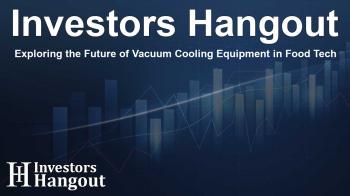Exploring the Future of Vacuum Cooling Equipment in Food Tech

Understanding the Growth of the Vacuum Cooling Equipment Market
The food industry vacuum cooling equipment market is on an impressive growth trajectory, with predictions estimating an increase of USD 7.41 million from 2025 to 2029. This surge can be attributed primarily to the growing focus on food quality maintenance and the emerging influence of artificial intelligence (AI) within the sector. As technology continues to advance, the adoption of vacuum cooling solutions becomes more appealing to food processors aiming to enhance their production efficiency and maintain stringent quality standards.
The Role of AI in Shaping Market Trends
AI technology is revolutionizing various industries, and the food sector is no exception. By leveraging AI, companies can optimize their cooling processes, reduce wastage, and streamline operations. AI-powered analytical tools provide insights into market trends, enabling businesses to make informed decisions that align with consumer demands for fresh and high-quality products. These innovations are instrumental in driving the growth of vacuum cooling equipment as they enhance efficiency and reduce operational costs.
Increasing Adoption of Screw Vacuum Pumps
One of the significant trends contributing to the growth of the vacuum cooling equipment market is the rising adoption of screw vacuum pumps. These pumps facilitate a highly efficient cooling process without the introduction of oil, thus reducing contamination risks. They require minimal maintenance and are designed to handle varying levels of moisture, making them an ideal choice for the food industry. Their cost-effectiveness and energy efficiency further popularize their use, setting a benchmark within the market.
Challenges Facing the Market
Despite the positive outlook, the vacuum cooling equipment market faces challenges, particularly from the growing utilization of alternative cooling systems such as hydro coolers. Companies that use hydro coolers benefit from reduced weight loss and superior preservation of food quality. As demand for these cooling alternatives increases, food processors may lean towards these options rather than traditional vacuum cooling methods, potentially impacting market growth.
Maintaining Energy Efficiency and Cost Control
Energy costs and maintenance expenses associated with vacuum cooling systems remain key concerns for businesses. Continuous advancements in technology are necessary to ensure not only efficiency but also cost-effectiveness in operations. To remain competitive, manufacturers must develop solutions that prioritize energy savings without compromising on performance or food safety.
Vacuum Cooling Equipment Market Segmentation
The vacuum cooling equipment market can be segmented into various categories based on type, application, and geography:
- Type:
- Air Cooled Vacuum Cooler
- Water Cooled Vacuum Cooler
- Application:
- Baked Products
- Meat Products
- Fruits and Vegetables
- Ready-made Food
- Geography:
- Europe
- APAC
- North America
- South America
- Middle East and Africa
Market Opportunities and Innovations
The evolution of the food industry vacuum cooling equipment market opens a plethora of opportunities, particularly with the rising demand for ready-to-eat and convenient food options. Companies are adopting vacuum cooling methods that maintain food quality and safety while enhancing shelf life. This focus on sustainability and innovation is paramount for manufacturers seeking to thrive in a competitive landscape.
The Future of the Food Industry Vacuum Cooling Equipment Market
As the food industry landscape continues to evolve, the vacuum cooling equipment market will likely witness significant innovations driven by technology and consumer preferences. Businesses that embrace these trends and invest in efficient cooling solutions will position themselves for success in meeting the demands of an ever-changing market.
Frequently Asked Questions
What factors are driving growth in the vacuum cooling equipment market?
The growth is driven by an increased focus on food quality maintenance and advancements in AI technology that optimize cooling processes.
How does AI impact the food industry vacuum cooling market?
AI enhances operational efficiency, reduces waste, and provides actionable insights to align production with consumer demands.
What challenges does the vacuum cooling equipment market face?
Challenges include competition from hydro coolers and the need for energy efficiency and cost-effective operations.
What are the primary applications for vacuum cooling equipment?
Vacuum cooling is predominantly utilized in cooling baked goods, meat, fruits, vegetables, and ready-made food products.
What is the significance of screw vacuum pumps in this market?
Screw vacuum pumps offer efficient cooling without oil contamination, requiring less maintenance while being energy-efficient.
About The Author
Contact Addison Perry privately here. Or send an email with ATTN: Addison Perry as the subject to contact@investorshangout.com.
About Investors Hangout
Investors Hangout is a leading online stock forum for financial discussion and learning, offering a wide range of free tools and resources. It draws in traders of all levels, who exchange market knowledge, investigate trading tactics, and keep an eye on industry developments in real time. Featuring financial articles, stock message boards, quotes, charts, company profiles, and live news updates. Through cooperative learning and a wealth of informational resources, it helps users from novices creating their first portfolios to experts honing their techniques. Join Investors Hangout today: https://investorshangout.com/
The content of this article is based on factual, publicly available information and does not represent legal, financial, or investment advice. Investors Hangout does not offer financial advice, and the author is not a licensed financial advisor. Consult a qualified advisor before making any financial or investment decisions based on this article. This article should not be considered advice to purchase, sell, or hold any securities or other investments. If any of the material provided here is inaccurate, please contact us for corrections.

